Why Small-Medium Businesses Should Never Discount “E-Commerce” Again
3 Quick Steps to Dominate Your B2B E-Commerce Presence to Grow Sales
The covid-19 pandemic has shattered most industries, altered many verticals and created new opportunities within. It’s no secret that the way business is conducted in 2021 is dramatically different than prior to 2020. Sales calls are conducted virtually, calendars are jam-packed with endless Zoom meetings and most importantly, in-person meetings are not anywhere close to coming back.
Which pegs the following questions:
- What does covid-19 mean for B2B business?
- How can businesses close more sales virtually?
- How do we transition B2B businesses to the digital age?
These are just some of the questions being discussed across the board rooms and the executive sweet.
But there is good news! The human race is notoriously known for being the most adaptive species. Remember what you were taught in high-school regarding Darwin’s Theory of Natural Selection?
Organisms with heritable traits that favor survival and reproduction will tend to leave more offspring than their peers, causing the traits to increase in frequency over generations.
Business parallels the theory of natural selection. In fact, we can go so far as saying it mirrors it!
Let’s look at the following analogy:
In the business-sense, organisms are the SMEs and large organizations of the world. Their traits relate to their core capabilities, points of differentiation, human capital, culture etc. When a small business has incredible competitive advantages, a core value-proposition that emphasizes differentiation and a workforce that’s incredibly satisfied with their environment, business thrives!
The more a small business is successful in these verticals, the more momentum is built. The more momentum a business has, the more likely it is to innovate and reproduce top-line sales opportunities. Over time, as businesses become more successful through strengthening its operational systems and gains momentum, they start developing unique competitive advantages (read: traits that favor survival and reproduction).
Business is a game of the wild wild west – compete and innovate or become extinct!
Over time, as a small business adapts to the environment, it naturally builds itself for the future.
Prior to 2020, B2B businesses were heavily reliant on outbound tactics to generate sales opportunities (& rightfully so!).
However, as the contagious virus ravaged the earth, restricting the ability to conduct business in person, cold calling stakeholders at their offices and such, it hindered their ability to compete.
Hence, we are seeing an incredible trend in B2B towards e-commerce. The move is essential to maximize touch point frequency with prospects, as more and more people are conducting business virtually.
How COVID-19 Changed Small Businesses Forever
Let’s take a look at the business impact of covid-19 on small-medium businesses.
StatCan’s recent study found that nearly 11% of businesses in Canada with 1-20 employees considered bankruptcy or closing as a result of the pandemic. Similarly, larger organizations also had nearly the same sentiment.
That’s nearly 10% of the Canadian economy.
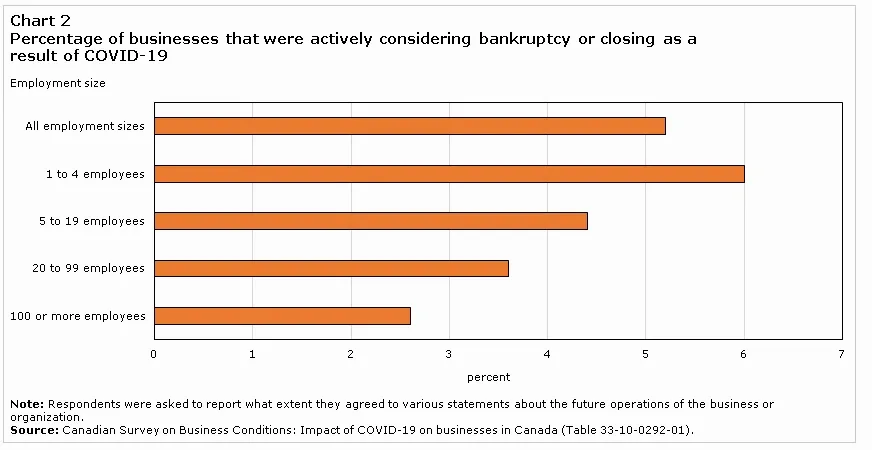
Looking at the chart above, it’s easy to just blame the pandemic for ravaging small-medium businesses across Canada and the world. However, the key to success in analyzing any data set is to asking why this is occurring.
Take a look at the following stats again from StatCan:
- Only 25% of Canadian businesses had some e-commerce sales in 2019.
- That’s merely 8% of total Canadian revenues and only 1% of total global e-commerce sales.
- 39% of those e-commerce sales were generated from large organizations.
- 34% of those e-commerce sales were generated from medium businesses.
- 23% of those e-commerce sales were generated from small-businesses
Despite the dramatically small proportion of overall sales generated from e-commerce in Canada and the world, more interesting findings reveal that B2B e-commerce is on the up rise:
- The majority of Canadian e-commerce sales in 2019 was generated by B2B businesses.
- The largest B2B e-commerce industries as of 2019 are:
- Wholesales trade (85$ billion)
- Transportation and warehousing ($60 billion).
- Manufacturing ($38 billion).
· In terms of B2C (retail) e-commerce, these types of businesses were the smallest contributors to e-commerce sales in Canada ($22 billion).
Therefore, we can infer that most or nearly of businesses struggling with the pandemic had little to no e-commerce presence.
What does this mean for your B2B business?
Well, your competition is moving more and more towards e-commerce, nearly eliminating most middlemen. Given these figures, it is essential that you have the right framework for adding another source of revenue from an e-commerce channel.
I’ll tell you how right now with 3 quick moves to generate B2B e-commerce sales.
Step 1: Define Your B2B E-Commerce Strategy
Clients know me for being a typhoon of strategy. Without a clear strategy for executing your e-commerce business, good execution is nearly impossible. Having a clear and defined strategy enables business leaders, investors, sales and marketing teams and founders to think 5 moves ahead. Business strategy positions your company for not only survival but domination.
To have the right strategy in place, you need a framework.
Introducing the 3Cs Framework: Customer, Company, Competition
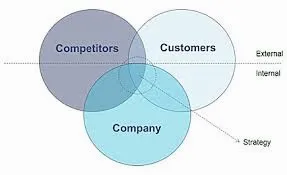
3Cs Framework: Customers, Competitors, Company
The 3Cs framework is works for any business, whether you operate a direct-to-consumer (DTC) business or B2B, a manufacturing plant or a retail store. It is an extremely agile model because its industry agnostic.
Let’s get started.
Who Are Your B2B Customers, Exactly?
No business can succeed without having up to date information on their customers. You must continuously be in sync with customers’ wants and needs, respectively. This is why us marketers put heavy emphasis in creating buyer profiles (buyer personas). They serve as the foundation of any new product launch, product development strategy, sales and marketing training and more!
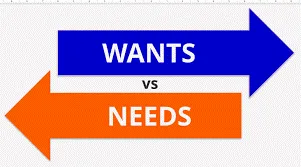
Customer Wants versus Needs
Accurate and up to date buyer profiles help us understand he difference between customers’ wants and needs. Understanding these differences can save your business money, time and resources.
What’s the difference between a want and a need?
There is no reason to complicate the two. Just think about it this way: what a business owner wants might not be what a business owner needs. It’s that simple.
Marketing and sales are all about pinpointing the explicit needs of customers, not the wants.
When we know the explicit need of our target customers, we can fine-tune the messaging on your e-commerce store and marketing materials to:
- Improve click-through rates (CTRs) on your e-commerce website.
- Drive up conversion rates on your B2B lead generation.
- Dramatically improve page-bounce rates and add-to-cart completion metrics.
Now that we’ve outlined the importance of knowing the difference between our customers’ needs and wants and how they impact the business, let’s turn back to strategy.
Most strategists and marketers will talk a big game when it comes to theory, yet they do not deep dive into how to implement it (probably because they don’t know how). My goal with this article is for you to start implementing what I share with you and generate quick wins for your business.
Given that there is so much we can talk about on strategy and much of it depends on the business case, I’ll keep it simple.
What offline B2B sales tactics apply to B2B e-commerce sales?
The B2B landscape is a special beast. Compared to a DTC business, B2B lead generation requires a more thorough understanding of customers, sales are much more complicated and typically average 3 months and sales skills dramatically differ from the DTC model (transactional sales).
Let’s focus on the latter.
In any discovery call, we must uncover the needs of our customers. We target prospects we assume have some type of need for our products or services based on our customer profiles. Once we land the call, it is the role of sales to get prospects to turn their implied needs to explicit ones.
How?
By asking thought-provoking questions. Discovery is all about turning implied needs into explicit needs. More on the two here.
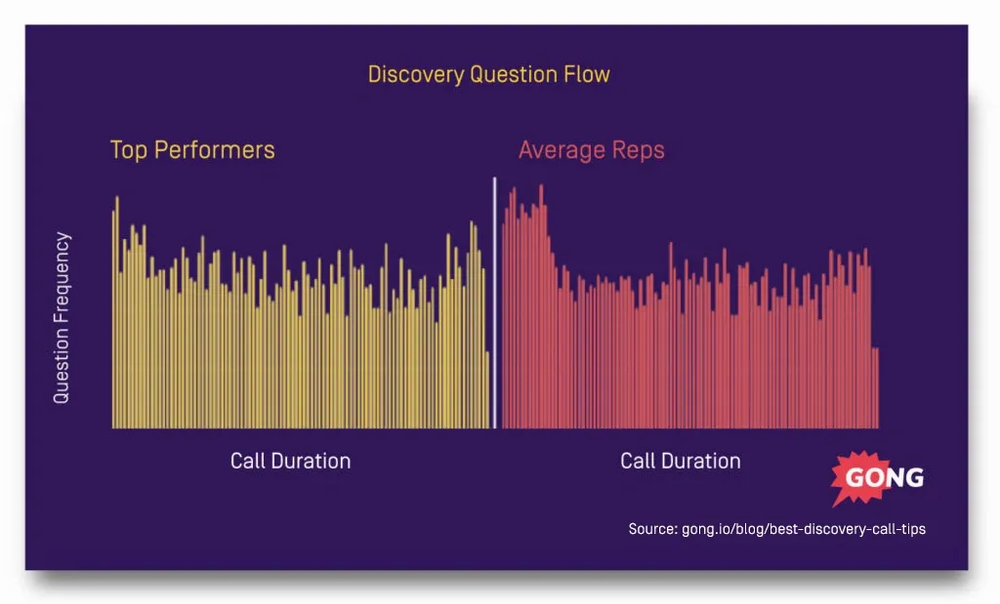
Top Performing Sales Person Strategies
Look at the following graph from Gong. In their analysis, top sales reps benefit from much longer call durations by asking intelligent and thought-provoking questions.
Therefore, what sales reps used to ask in sales calls proves extremely helpful for profiling and segmenting customers.
Here’s a quick formula for profiling customers with sales teams:
Profile customers with the BANT framework:
- Budget: what type of companies and people has the budget for our offering?
- Authority: what type of stakeholder makes the buying decision at our target company?
- Need: what is the explicit need of our target customers?
- Timing: when do they need this by?
Understanding the customer through these lenses and in detail will help position your B2B e-commerce store’s messaging, marketing campaigns, and lead generation to attract the right stakeholder.
Once you know their explicit needs for instance, your marketing team can derive the right type of content to deliver to your target audience to instigate a buying trigger.
Who Are Your B2B E-Commerce Competitors and How Can You Beat Them?
Competition and industry growth are positively correlated: businesses seek to maximize profit by converging towards growth-oriented industries.
As we’ve outlined earlier, e-commerce is on the rise due to the pandemic. Therefore, we can assume that B2B e-commerce will only get more competitive in the following years.
Your competition might come from direct competitors or indirect ones (firms that sell products or services that differ from yours but can have the same value on customers). Similarly, competition can also stem from existing suppliers and customers looking to penetrate your market.
With regards to your new e-commerce operations, ask yourself the following:
Who are your major e-commerce competitors?
- What products or services do they offer?
- What are delivery lead times?
- Do they charge for shipping or offer free-shipping?
- How do they promote their products (through what marketing channels)?
- What are their policies for returns?
- What is their business model (subscription or transactional)?
Can you segment the competition?
- What distribution channels are all your competitors using?
- Where are they operating from?
- What types of product lines and SKUs are they promoting mostly?
- What proportion of revenues and market share come from offline and e-commerce channels?
Who are your competitors without an e-commerce presence yet?
- Find out if they are investing currently in an e-commerce store.
Take an Honest Look at Your Company
Finally, phase 3 of the 3Cs framework aims to take an in-depth look at your company and from an objective point of view. Without getting clear on who you are and your position in the marketplace, positioning is impossible.
Again, keeping your e-commerce strategy in mind, identify the following:
What is your competitive advantage offline?
- Identify the resources and capabilities at your disposal.
- What types of product lines or services is your company weak in right now?
- Identify your passion-fruit: why are you selling XYZ types of products or services? What are you passionate about solving for your customers?
- What can you be the best at right now? What can you not be the best at right now (strive to gain to this place)?
- How can your offline competitive advantage translate into an e-commerce advantage?
What is your competitive strategy?
- Directly related to your business model and competitors, are you selling products or services with a higher-perceived value?
- Are you mainly focused on volume and selling at low-cost?
- Is your product/service a commodity or differentiated?
These are just SOME of the questions you should be asking internally about your company. The goal is that it helps you identify your position in the market as it relates to e-commerce.
Packaging it All Together
Now that we’ve outlined customers’ needs, competitors’ model and our company’s core capabilities, we must define our e-commerce goals.
Corporate level goals:
- Are you looking to fully-transition your B2B business to e-commerce or simply looking to add another source of revenue?
- How will you be promoting your e-commerce store: through organic content or paid-traffic?
E-Commerce specific goals include:
- Increase revenue or the number of customers?
- Reduce your cost-structure?
- Improve the customer experience?
- Freeing up time for your sales and support teams?
The goals for your B2B e-commerce strategy can vary. These are just ideas as to what your goals can be.
Once you have goals, it’s time to formalize them company-wide and translate them into business objectives. For your e-commerce strategy to work, the whole company must be aligned on your goals, especially the sales and marketing teams.
I recommend the Objectives and Key Results (OKRs) framework. You can find a detailed breakdown of my OKR process with clients and How to Align Sales and Marketing Teams to Boost Productivity here
Step 2: Invest in The Right Technologies to Improve the Customer Experience
To be the best, you have to invest in the best! Given the high-growth nature of B2B e-commerce, it is imperative that your business provides a customer experience that trounces your competition, drives client retention, minimizes your customer acquisition costs and drives up the lifetime-value (LTV) of customers.
Before we jump into the what you should invest in to boost your e-commerce experience, we must understand … you guessed it, customers’ needs!
Take a look at the following graph from a Statista survey which analyzed key online purchase influences according to online shoppers in Canada as of January 2018.
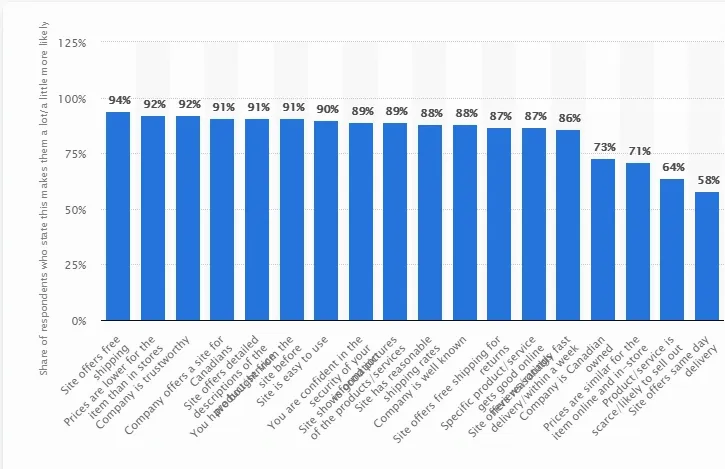
Key online purchase influences according to online shoppers in Canada as of January 2018
While there are lots of data points here, I’ll save you the hassle of reading through it all. The top 3 purchasing influences are:
- Site offers free shipping (94%)
- Prices are lower for items than in-store (92%)
- Company is trustworthy (92%)
No doubt, these are evidently important levers to consider for your e-commerce store as it relates to your competitive strategy.
But the survey reveals other meaningful data as it relates to the customer experience:
- Site offers detailed descriptions of the products or services (91%).
- Site is easy to use (90%).
- Site shows good pictures of the products or services offered (89%).
What does this mean for your e-commerce operations?
You must invest in innovative tools. That simple.
A big trend right now in optimizing e-commerce operations is in utilizing Natural Language Processing in your e-commerce product-search engine.
To improve product visibility, search participation rate, click-through rates, client retention and so forth, your customers have to be able to find their desired products or services fast! The less friction in finding their products, the better.
Customers that search are converted 3-5X more than customers that simply scan a website – Neil Patel.
Your product-search engine MUST be able to understand search terms as naturally as possible. After all, if we do not communicate like our customers do, it means our messaging needs some work.
Fewer than 10% of people search for products but represents 25% of annual e-commerce turnover – Wordstream.
To improve product visibility, your search-product engine must be able to annotate search terms, process synonyms and natural expressions and understand when synonyms are being used. Finally, let’s not forget that it be able to typeahead of the consumers and recommend related product lines.
I’ll recommend two products you must consider for your e-commerce operations to blow up conversion rates.
1. Detectum – Product Search Engine Uses Natural Language Processing
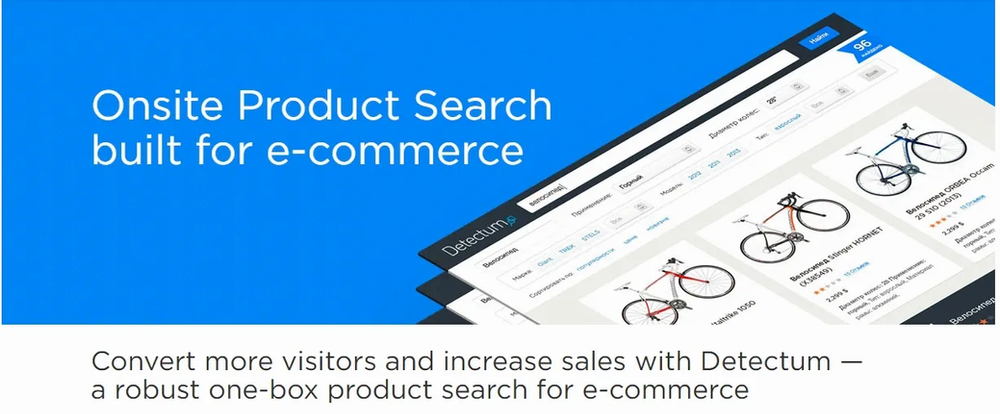
Product Search Engine Uses Natural Language Processing
The beauty in the Detectum tool is in their commitment to provide value and results first, and then get paid on the conversions!
Detectum provides:
- Spelling correction and synonyms.
- Multiple search criteria: categories, brands, colors, sizes (annotations).
- Query auto-complete in search box (typeahead).
- Self-learning product ranking using machine learning algorithms based on user clicks and purchases history.
All you need to get started is:
- Product list with parameters in XML format.
- Prior search query log.
2. Coveo – AI-Powered E-Commerce Recommendation Engine

AI-Powered E-Commerce Recommendation Engine
Coveo helps e-commerce shops find the best products faster! The platform is notoriously known for recommending products automatically based on a customer’s browsing and buying behavior, what’s already in their cart, or what’s often viewed and bought together.
What’s even better?
Their recommendation engine integrates remarkable well with Zendesk, Salesforce and other CRM platforms.
Step 3: Optimize Your E-Commerce Performance with Data Analytics
Final step in your e-commerce strategy is in optimizing and fine-tuning your operations with data. Data science is an art more than it is science. Understanding what your ideal customer acquisition channels are and where to allocate more resources starts with having a good handle on your analytics (Google Analytics, Facebook Manager, Shopify Dashboards etc.).
To analyze your data, you might want to seek a third-party consulting firm like Toledo or task one of your internal resources with analyzing the gaps.
Where you might need help from Toledo is in embedding predictive analytics to predict future consumer behavior and understand ahead of time when to promote certain SKUs or product lines (ex: Christmas or Easter etc.).
Conclusion
To transition your B2B business to e-commerce, you must have a clear and actionable strategy that aligns all your teams. Through understanding your customers’ needs, your competitors in the market and your company, you’re able to position your e-commerce operations strategically and derive clear goals and objectives for your business.
Once everything is set up, you can start optimizing the customer experience (CX) of your e-commerce store with tools that use machine learning to provide a frictionless search experience. Once the data is in, you can fine-tune your strategy and create a marketing strategy that will deliver real-results, real-revenue and real-ROI on your marketing budget.
If you need help in crafting a B2B e-commerce strategy or a B2B e-commerce marketing strategy, connect with us today.

